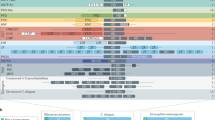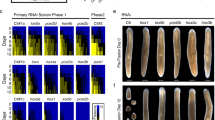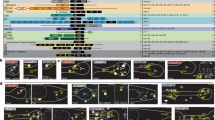Abstract
ANTENNAPEDIA class homeobox (Hox) genes specify cell fates in successive anteroposterior body domains in vertebrates, insects and nematodes1-3. The DNA-binding homeodomain sequences are very similar between vertebrate and Drosophila Hox proteins, and this similarity allows vertebrate Hox proteins to function in Drosophila4-7. In contrast, the Caenorhabditis elegans homeodomains are substantially divergent8. Further, C. elegans differs from both insects and vertebrates in having a non-segmented body as well as a distinctive mode of development that involves asymmetric early cleavages and invariant cell lineages. Here we report that, despite these differences, Drosophila Hox proteins expressed in C. elegans can substitute for C. elegans Hox proteins in the control of three different cell-fate decisions: the regulation of cell migra-tion, the specification of serotonergic neurons, and the specification of a sensory structure. We also show that the specificity of one C elegans Hox protein is partly determined by two amino acids that have been implicated in sequence-specific DNA binding. Together these findings suggest that factors important for target recognition by specific Hox proteins have been conserved throughout much of the animal kingdom.
This is a preview of subscription content, access via your institution
Access options
Subscribe to this journal
Receive 51 print issues and online access
$199.00 per year
only $3.90 per issue
Buy this article
- Purchase on Springer Link
- Instant access to full article PDF
Prices may be subject to local taxes which are calculated during checkout
Similar content being viewed by others
References
McGinnis, W. & Krumlauf, R. Cell 68, 283–302 (1992).
Kenyon, C. Cell 78, 175–180 (1994).
Krumlauf, R. Cell 78, 191–201 (1994).
Malicki, J., Bogarad, L. D., Martin, M. M., Ruddle, F. H. & McGinnis, W. Development 42, 139–150 (1993).
Zhao, J. J., Lazzarini, R. A. & Pick, L. Genes Dev. 7, 343–354 (1993).
Malicki, J., Schughart, K. & McGinnis, W. Cell 63, 961–967 (1990).
McGinnis, N., Kuziora, M. A. & McGinnis, W. Cell 63, 969–976 (1990).
Gehring, W. J., Affolter, M. & Burglin, T. A. Rev. Biochem. 63, 487–526 (1994).
Salser, S. J. & Kenyon, C. Trends Genet. 10, 159–164 (1994).
Sulston, J. E. & Horvitz, H. R. Devl Biol. 56, 110–156 (1977).
Wang, B. B. et al. Cell 74, 29–42 (1993).
Clark, S. G., Chisholm, A. D. & Horvitz, H. R. Cell 74, 43–55 (1993).
Kenyon, C. Cell 46, 477–487 (1986).
Salser, S. J. & Kenyon, C. Nature 355, 255–258 (1992).
Zeng, W., Andrew, D. J., Mathies, L. D., Horner, M. A. & Scott, M. P. Development 118, 339–352 (1993).
Furukubo-Tokunaga, K., Flister, S. & Gehring, W. J. Proc. natn. Acad. Sci. U.S.A. 90, 6360–6364 (1993).
Ekker, S. C. et al. EMBO J. 13, 3551–3560 (1994).
Loer, C. M. & Kenyon, C. J. J. Neurosci. 13, 5407–5417 (1993).
Salser, S. J., Loer, C. M. & Kenyon, C. Genes Dev. 7, 1714–1724 (1993).
Sulston, J. E., Albertson, D. G. & Thomson, N. J. Devl Biol. 78, 542–576 (1980).
Russnak, R. H. & Candido, E. P. M. Molec. cell. Biol. 5, 1268–1278 (1985).
Han, M. & Sternberg, P. W. Cell 63, 921–931 (1990).
Mello, C. C., Kramer, J. M., Stinchcomb, D. & Ambros, V. EMBO J. 12, 3959–3970 (1991).
Author information
Authors and Affiliations
Rights and permissions
About this article
Cite this article
Hunter, C., Kenyon, . Specification of anteroposterior cell fates in Caenorhabditis elegans by Drosophila Hox proteins. Nature 377, 229–232 (1995). https://doi.org/10.1038/377229a0
Received:
Accepted:
Issue Date:
DOI: https://doi.org/10.1038/377229a0
Comments
By submitting a comment you agree to abide by our Terms and Community Guidelines. If you find something abusive or that does not comply with our terms or guidelines please flag it as inappropriate.



